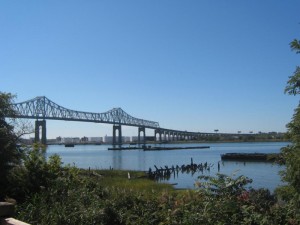
Dr. William Wallace and his team at CSI are investigating ways to restore the area's waterways. (Photo by Dr. William Wallace.)
A few years ago, a laboratory group led by Dr. William Wallace, Professor of Biology at CSI, had a project funded through the New York Sea Grant (NYSG), which focused on, according to Wallace, “understanding the processes involved with the trophic transfer of cadmium and mercury in marine ecosystems.”
The approximately $100,000 grant marked the first time that the NYSG funded a project from CSI. During grant’s one-year tenure, the research team, led by Dr. Wallace and Sea Grant Scholar Daisuke Goto, looked at how toxic metals move up the levels of a food chain. “We gained some great traction and produced a good variety of datasets that helped form the basis of D. Goto’s PhD project,” Wallace said.
The project, which focused on the Arthur Kill, involved the research team using techniques ranging from intensive field studies to elaborate experimental systems to study how the toxic metals cadmium and mercury move from prey to predators in model esturine food chains. According to Wallace, “The toxic metals released into the environment first stick to sediment, [and] critters, like worms and clams, eat that sediment and accumulate the metal. Then predators eat these prey items and can, themselves, accumulate this metal.” The team found that cadmium is typically not readily available to predators (although in some cases it can be) but mercury was readily transferred up the food chain, which is in line with previous studies on this toxic metal.
The funding was invaluable because it allowed the research team to not only gain experience in working with mercury for ongoing projects but it also allowed them access to the instruments for working with mercury. “If it wasn’t for the funding, we could never have acquired that equipment,” said Wallace. “Being able to include mercury in our studies is quite exciting.”
The project ended up being so successful that, in composite, the research team produced a good many journal articles based on this research. The funding agency was so impressed with that level of productivity that they invited Wallace to help pen an article for the spring 2011 issue of Sea Grant’s newsletter, Coastlines. Wallace is quick to point out, however, that the students in the team deserve most of the credit. “They did the work,” he said. “I was just the manager making sure they stayed on task. We squeezed every last drop of data out of that project and it was quite rewarding. To be approached by the funding agency because they themselves felt that our efforts and productivity were atypically on the high end was certainly an endorsement of how I have always viewed myself and my lab group.”
Wallace believes CSI is the perfect venue for projects such as this one because of its proximity to vulnerable waterways. The data gathered from this project may be of interest to municipalities doing habitat restoration work or aid in planning restoration efforts for many waterways.
He also credits CSI with sharing his enthusiasm for adding mercury to the types of pollutants on which his research group works. Initially, Wallace’s lab facilities could not accommodate this additional research component, but the CSI administration helped facilitate renovations to laboratories under his auspices. Wallace continues, “The ability to include mercury in our projects has really opened to door to not only graduate students but also undergraduates as well…”
Always looking to expand and build upon previous successes, Wallace is now working in collaboration with researchers from Rutgers University investigating atmospheric mercury in New York/New Jersey area. Because mercury is such a ubiquitous pollutant, first entering the atmosphere from the combustion of fossil fuels and then making its way to local waterways, Wallace believes that this new effort is the first step in forging a long-term collaboration between the two institutions.
While it is true that local environments are vulnerable to mercury as well as other pollutants, Wallace stresses that current conditions are much better than in years past, although that improvement is the result of education, proper regulations, and continued research on how these pollutants interact in the environment.
“CSI is in a unique position in the Tri-state-area,” said Wallace. “Staten Island waterways are vulnerable to these pollutants.” While this may sound ominous, it is fortunate we have professors like Dr. Wallace and students like Goto to help protect our waterways from these pollutants.
For more information on the NYSG or to read a copy of the newsletter visit the NYSG Website.

















